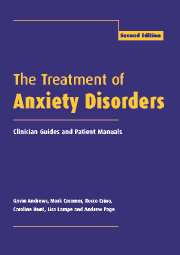Book contents
- Frontmatter
- Contents
- List of authors
- Preface to the second edition
- Abbreviations
- 1 Read me
- 2 General issues in anxiety disorders
- 3 General issues in treatment: Clinician Guide
- 4 Panic disorder and agoraphobia: Syndrome
- 5 Panic disorder and agoraphobia: Treatment
- 6 Panic disorder and agoraphobia: Clinician Guide
- 7 Panic disorder and agoraphobia: Patient Treatment Manual
- 8 Social phobia: Syndrome
- 9 Social phobia: Treatment
- 10 Social phobia: Clinician Guide
- 11 Social phobia: Patient Treatment Manual
- 12 Specific phobias: Syndrome
- 13 Specific phobias: Treatment
- 14 Specific phobias: Clinician Guide
- 15 Specific phobias: Patient Treatment Manual
- 16 Obsessive-compulsive disorder: Syndrome
- 17 Obsessive-compulsive disorder: Treatment
- 18 Obsessive-compulsive disorder: Clinician Guide
- 19 Obsessive-compulsive disorder: Patient Treatment Manual
- 20 Generalized anxiety disorder: Syndrome
- 21 Generalized anxiety disorder: Treatment
- 22 Generalized anxiety disorder: Clinician Guide
- 23 Generalized anxiety disorder: Patient Treatment Manual
- 24 Posttraumatic stress disorder: Syndrome
- 25 Posttraumatic stress disorder: Treatment
- 26 Posttraumatic stress disorder: Clinician Guide
- 27 Posttraumatic stress disorder: Patient Treatment Manual
- 28 Conclusions
- References
- Index
6 - Panic disorder and agoraphobia: Clinician Guide
Published online by Cambridge University Press: 05 August 2016
- Frontmatter
- Contents
- List of authors
- Preface to the second edition
- Abbreviations
- 1 Read me
- 2 General issues in anxiety disorders
- 3 General issues in treatment: Clinician Guide
- 4 Panic disorder and agoraphobia: Syndrome
- 5 Panic disorder and agoraphobia: Treatment
- 6 Panic disorder and agoraphobia: Clinician Guide
- 7 Panic disorder and agoraphobia: Patient Treatment Manual
- 8 Social phobia: Syndrome
- 9 Social phobia: Treatment
- 10 Social phobia: Clinician Guide
- 11 Social phobia: Patient Treatment Manual
- 12 Specific phobias: Syndrome
- 13 Specific phobias: Treatment
- 14 Specific phobias: Clinician Guide
- 15 Specific phobias: Patient Treatment Manual
- 16 Obsessive-compulsive disorder: Syndrome
- 17 Obsessive-compulsive disorder: Treatment
- 18 Obsessive-compulsive disorder: Clinician Guide
- 19 Obsessive-compulsive disorder: Patient Treatment Manual
- 20 Generalized anxiety disorder: Syndrome
- 21 Generalized anxiety disorder: Treatment
- 22 Generalized anxiety disorder: Clinician Guide
- 23 Generalized anxiety disorder: Patient Treatment Manual
- 24 Posttraumatic stress disorder: Syndrome
- 25 Posttraumatic stress disorder: Treatment
- 26 Posttraumatic stress disorder: Clinician Guide
- 27 Posttraumatic stress disorder: Patient Treatment Manual
- 28 Conclusions
- References
- Index
Summary
After formal diagnosis and assessment, two issues must be addressed before treatment is planned. First, the clinician, by conducting a thorough behavioral analysis, must identify the factors that trigger and maintain the panic attacks and the avoidance behavior. Second, the clinician must consider the eVects of comorbid disorders on treatment.
Behavioral analysis
The general principles and practice of behavioral analysis have been outlined elsewhere (Kirk, 1989;Schulte, 1997). However, in panic disorder and agoraphobia there are unique details to be considered. In terms of the antecedents of panic attacks, it is necessary to evaluate the physical and psychological triggers. These typically include situations previously associated with panic, certain physical sensations, and particular worrying thoughts (e.g., “Oh no! fihat if I had a panic attack right now?”). In addition, panic attacks will be more likely to occur when the person has been made more physically aroused as a result of being anxious, stressed, hot, smoking, drinking alcohol, taking stimulant drugs (e.g., coffee), and so on. In addition, panic attacks appear more likely when the individual is “run down”, perhaps because of illness (e.g., flu), physical and psychological stress (e.g., childbirth), or sleep deprivation. Once a listing of antecedents has been made, the consequences of panic attacks need to be identified. The consequences can be divided into three categories. First, individuals may respond to panic attacks with avoidance behavior. Commonly avoided agoraphobic situations have been described earlier, but for present purposes it is worth noting that identifying the cognitive link between panic attacks and avoidance will facilitate cognitive behavioral treatment (e.g., “I avoid crowded trains because the air may run out when everyone is breathing it”). Second, the subtle avoidance strategies (e.g., the use of safety signals) need to be identified. Finally, the social consequences of avoidance need to be evaluated. For instance, individuals with dependent traits may welcome the increased support given as a consequence of panic attacks and become more dependent. Such behavioral patterns need to be identified to ensure they do not inhibit progress in treatment.
Management of comorbid disorders
The most frequently comorbid axis I disorders are the other anxiety disorders, especially social phobia (Sanderson et al., 1990). One advantage of cognitive behavioral interventions is their applicability to all the anxiety disorders, in that each disorder responds to various combinations of anxiety-management and exposure strategies.
- Type
- Chapter
- Information
- The Treatment of Anxiety DisordersClinician Guides and Patient Manuals, pp. 65 - 83Publisher: Cambridge University PressPrint publication year: 2002



